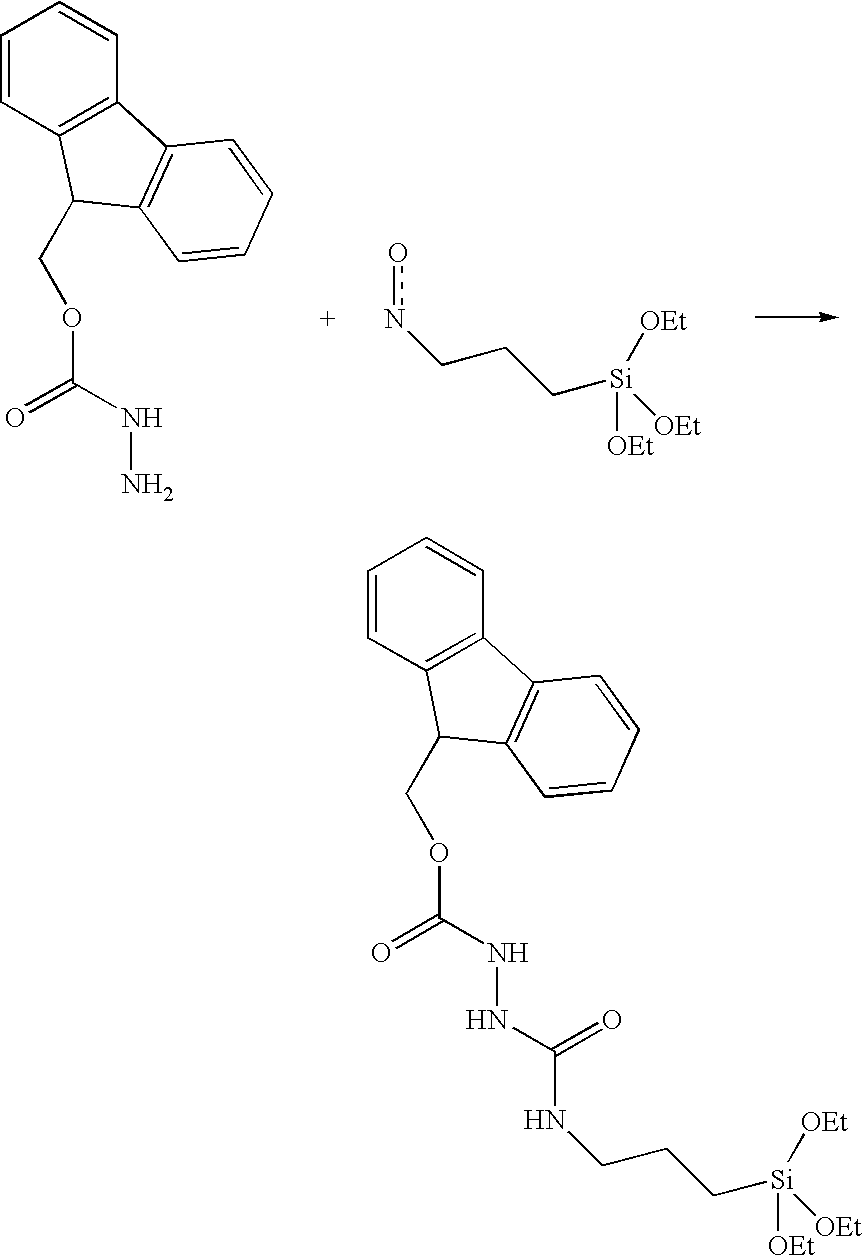Device for presentation of polypeptides able to be used as a chip for miniaturised detection of molecules
a polypeptide and chip technology, applied in the field of polypeptide devices, can solve the problems of large limitations, difficult to meet the needs of specific use,
- Summary
- Abstract
- Description
- Claims
- Application Information
AI Technical Summary
Benefits of technology
Problems solved by technology
Method used
Image
Examples
example 2
Checking of Quality of Semicarbazide Slides
[0104] It is important to check that the functionalisation of the slides is homogeneous and reproducible in order to guarantee homogeneous attachment of the polypeptides.
[0105] The quality of the slides is thus checked using the same reaction as that which will be used to attach the polypeptides. A small synthetic peptide functionalised with an .alpha.-oxo aldehyde group and labelled with rhodamine (fluorescent marker) is used, and, as negative control, the same peptide in which the .alpha.-oxo aldehyde is replaced by an amide group. The rhodamine-conjugated peptide functionalised with an .alpha.-oxo aldehyde group of sequence (5)-6-carboxytetramethylrhodamine--Lys-Arg-NH--(CH.sub.2).sub.3--NH--CO--CHO was synthesised from the linker PT (2,3-O-isopropylidene D-tartrate), described by J. S. Fruchart et al., H. Gras-Masse, O. Melnyk (A new linker for the synthesis of C-termninal peptid .alpha.-oxo aldehydes, Tet. Lett., 40, 6225-6228, 1999), ...
example 3
Synthesis of Test Peptides
[0110] The following peptides were synthesised (on an automatic synthesiser of the Pioneer PerSeptive Biosystem type).
[0111] 1--Peptides of the Hepatitis C Virus
[0112] HCVpc21-1 peptide functionalised with an .alpha.-oxo aldehyde group on the N-terminal side: 2
[0113] This peptide is solid phase synthesised from the C-terminal end towards the N-terminal end on the basis of an Fmoc strategy, on an Fmoc-PAL-PEG-PS resin (Perseptive Biosystems).
[0114] HCVpc21-2 peptide functionalised with a 4,7,10-trioxa-1,13-diamino--tridecanyl-.alpha.-oxo aldehyde group on the C-terminal side, "large linker": 3
[0115] This peptide is solid phase synthesised from the C-terminal end towards the N-terminal end on the basis of an Fmoc strategy, on a "methyl-2,3-O-isopropylidene-D-tartryl-Val-PEGA resin, prepared as described in "Peptides for the new millenium", Proceeding of the 16.sup.th American peptide symposium, (kluwer academic publishers, Dordrecht, 2000, p.104-106). 0.1 mol...
example 4
Protocol for Utilisation of the Semicarbazide Slides
[0123] 1. Ligation of Peptides
[0124] The functionalised peptides are firstly solubilised (at 10.sup.-3 M or 10.sup.-4 M) in 0.1 M acetate buffer, pH 5.5. They are then distributed into the wells of a 384-well ELISA plate (Microtest TM, Becton Dickinson, N.J. USA). By means of a manual "Spotter" with 32 needles (Microarray Printer XMM 47832-Xenopore, Hawthorne, US), the peptides are sampled from the ELISA plate and deposited onto a semicarbazide glass slide. The slides are then placed to incubate for 1 night at 37.degree. C. under a moist atmosphere.
[0125] These slides are then washed, by passage for 60 mins with ultrasonication in a solution of Tris acetate (0.IM tris(hydroxymethyl)-aminomethane--Merck, Darmstadt, Germany). The slides are then washed 4 times for 3 minutes in a solution of PBS (0.01M phosphate buffer with 1.8% added NaCl, pH 7.4) in the presence of 0.05% of Tween 20.
[0126] 2. Contacting with the Test Sera
[0127] The ...
PUM
| Property | Measurement | Unit |
|---|---|---|
| pH | aaaaa | aaaaa |
| pH | aaaaa | aaaaa |
| concentrations | aaaaa | aaaaa |
Abstract
Description
Claims
Application Information
 Login to View More
Login to View More - R&D
- Intellectual Property
- Life Sciences
- Materials
- Tech Scout
- Unparalleled Data Quality
- Higher Quality Content
- 60% Fewer Hallucinations
Browse by: Latest US Patents, China's latest patents, Technical Efficacy Thesaurus, Application Domain, Technology Topic, Popular Technical Reports.
© 2025 PatSnap. All rights reserved.Legal|Privacy policy|Modern Slavery Act Transparency Statement|Sitemap|About US| Contact US: help@patsnap.com



